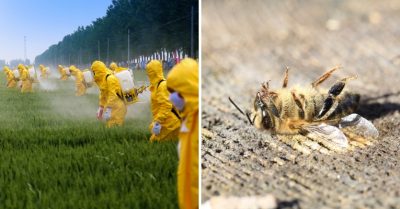Trump EPA OKs ‘Emergency’ Use of Bee-killing Pesticide on 13.9 Million Acres

The Environmental Protection Agency announced so-called “emergency” approvals today to spray sulfoxaflor — an insecticide it considers “very highly toxic” to bees — on nearly 14 million acres of crops known to attract bees.
The approval includes 2019 crops of cotton and sorghum in Alabama, Arkansas, California, Georgia, Kansas, Louisiana, Missouri, Mississippi, Tennessee, Texas and Virginia. Ten of the 11 states have been granted the approvals for at least four consecutive years for the same “emergency.” Five have been given approvals for at least six consecutive years.
“The only emergency here is the Trump EPA’s reckless approval of this dangerous bee-killing pesticide,” said Lori Ann Burd, environmental health director at the Center for Biological Diversity. “It’s sickening that even amid the current insect apocalypse, the EPA’s priority is protecting pesticide industry profits.”
The approvals include 5.8 million acres in Texas, which is home to more than 800 species of native bees. Monarch butterflies and eight species of bumblebees, including the rare American bumblebee and variable cuckoo bumblebee, live in Texas counties where cotton or sorghum are grown.
The EPA may approve temporary emergency uses of pesticides, including unapproved pesticides, if it determines they are needed to prevent the spread of an unexpected outbreak of insects.
But the agency has routinely abused this authority, as chronicled in the Center’s report, Poisonous Process: How the EPA’s Chronic Misuse of ‘Emergency’ Pesticide Exemptions Increases Risks to Wildlife. The report found that the alleged “emergencies” cited are foreseeable occurrences.
Last year the EPA’s Office of the Inspector General released a report finding that the agency’s practice of routinely granting “emergency” approval for pesticides across millions of acres does not effectively measure risks to human health or the environment.
In response to a lawsuit by beekeepers, the 9th Circuit Court of Appeals vacated the EPA’s original registration of sulfoxaflor in 2015. The EPA’s 2016 registration for sulfoxaflor — purportedly designed to ensure essentially no exposure to bees — excluded crops like cotton and sorghum that are attractive to bees.
“The Trump EPA is allowing potentially catastrophic harm to imperiled insect populations,” said Burd. “It’s hard to imagine how much more evidence could possibly be needed for the agency to wake up to the damage they are causing.”
A study published last year in Nature found that sulfoxaflor exposure even at low doses had severe consequences for bumblebee reproduction. The authors cautioned against the EPA’s current trajectory of replacing older neonicotinoids with nearly identical insecticides like sulfoxaflor. A major study published earlier this year found that more than 41 percent of the world’s insect species are on the fast track to extinction, and that a “serious reduction in pesticide usage” is key to preventing their extinction.
*
Note to readers: please click the share buttons above or below. Forward this article to your email lists. Crosspost on your blog site, internet forums. etc.

